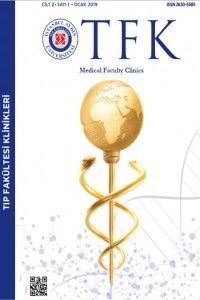
ÖZ Amaç: Son yıllarda süper besinler popüler bir beslenme tarzı haline gelmiştir. Süper besinler antioksidan bakımından zengin ve medyada besin içeriği yoğun gıdalar olarak belirtilmektedir. Tüketicilerin daha sağlıklı yaşam tarzları ve refah konusunda artan farkındalığı nedeniyle, süper gıdalar, fonksiyonel özellikleri ve farklı alanlardaki faydaları(antimikrobiyal, antitümör gibi) sebebiyle tercih edilirliği artmış besinler haline gelmiştir. Bu çalışma son dönemlerde popüler olan bu süper besinlere COVID-19 pandemi döneminde sağlık çalışanlarının bakış açılarını değerlendirmek amacıyla gerçekleştirilmiştir. Gereç ve Yöntem: 350 sağlık personelinin pandemi döneminde beslenme alışkanlıklarını sorgulayan anket uygulanmıştır. Veriler SPSS 20 paket programında değerlendirilmiştir. Bulgular: Araştırmaya dahil olan sağlık çalışanlarının COVID-19 pandemi döneminde en çok süper besin olarak belirtilen sarımsağın tüketimini arttırdığı(%17.2), bunu turşu (%14.1), sirke (%13.0) ve zencefilin (%11.8) takip ettiği bulunmuştur. Hastalıktan koruyuculuğunun olduğu düşünülen diğer besinler ise sırasıyla bal (%11.3), zerdeçal (%9.5), kefir (%9.0), pekmez (%7.3), sumak (%4.8) ve çörekotu (%2.0) şeklindedir. Pandemi döneminde sağlık çalışanlarının besin takviyesi kullanımları incelendiğinde ise %21.8 oranı ile en fazla D vitamini, bunu %17.5 oranı ile C vitamini ve %9.8 oranı ile B12 vitamini takip ettiği görülmüştür. Sarımsağın bağışıklık güçlendirici etkisi sebebiyle pandemide sağlık çalışanları tarafından da tüketiminin arttığı görülürken endüstriyel olarak üretilen besin takviyesi formu sağlık çalışanları tarafından en az tercih edilen takviye gıda olarak bulunmuştur (%0.5). Bu durum sağlık çalışanlarının besinlerin doğal hallerinin tüketimine daha yatkın olduklarını göstermektedir. Sonuç: Bu araştırma pandemide sağlık çalışanlarının süper besin tüketiminin ve besin takviye alımlarının arttığını gösterse de bu besinlerin ve takviye ürünlerin insan vücudundaki etkilerinin daha net açıklanabilmesi için demografik özelliklerinde (cinsiyet, yaş gibi) ele alındığı güvenilir alım düzeylerinin belirlendiği yeni çalışmalara ihtiyaç duyulmaktadır.
ABSTRACT Objective: In recent years, superfoods have become a popular diet. Superfoods are antioxidant-rich and nutrient-dense foods in the media. Due to the increasing awareness of consumers about healthier lifestyles and well-being, superfoods have become foods that have increased preference due to their functional properties and benefits in different areas (such as antimicrobial, antitumor). This study was carried out to evaluate the perspectives of healthcare professionals on these recently popular superfoods during the COVID-19 pandemic period. Materials and Methods: A questionnaire questioning the nutritional habits of 350 health personnel during the pandemic period was applied. The data were evaluated in the SPSS 20 package program. Results: It was found that the healthcare professionals involved in the study increased the consumption of garlic, which is the most superfood, during the COVID-19 pandemic period (17.2%), followed by pickles (14.1%), vinegar (13.0%) and ginger (11.8%). Other foods thought to be protective against the disease are honey (11.3%), turmeric (9.5%), kefir (9.0%), molasses (7.3%), sumac (4.8%) and black cumin (2.0%), respectively. When the nutritional supplement use of healthcare workers during the pandemic period was examined, it was seen that vitamin D was the highest with 21.8%, followed by vitamin C with 17.5% and vitamin B12 with 9.8%. Due to the immune-enhancing effect of garlic, it was observed that the consumption of health workers increased during the pandemic, while the industrially produced nutritional supplement form was found to be the least preferred supplement by health workers (0.5%). This shows that health workers are more inclined to consume the natural forms of foods. Conclusion: Although this research shows that health care workers' superfood consumption and nutritional supplement intake have increased during the pandemic, new studies are needed to determine reliable intake levels in demographic characteristics (such as gender, age) in order to better explain the effects of these foods and supplements on the human body.

| Relevant Articles | Author | # |
|---|
| Article | Author | # |
|---|